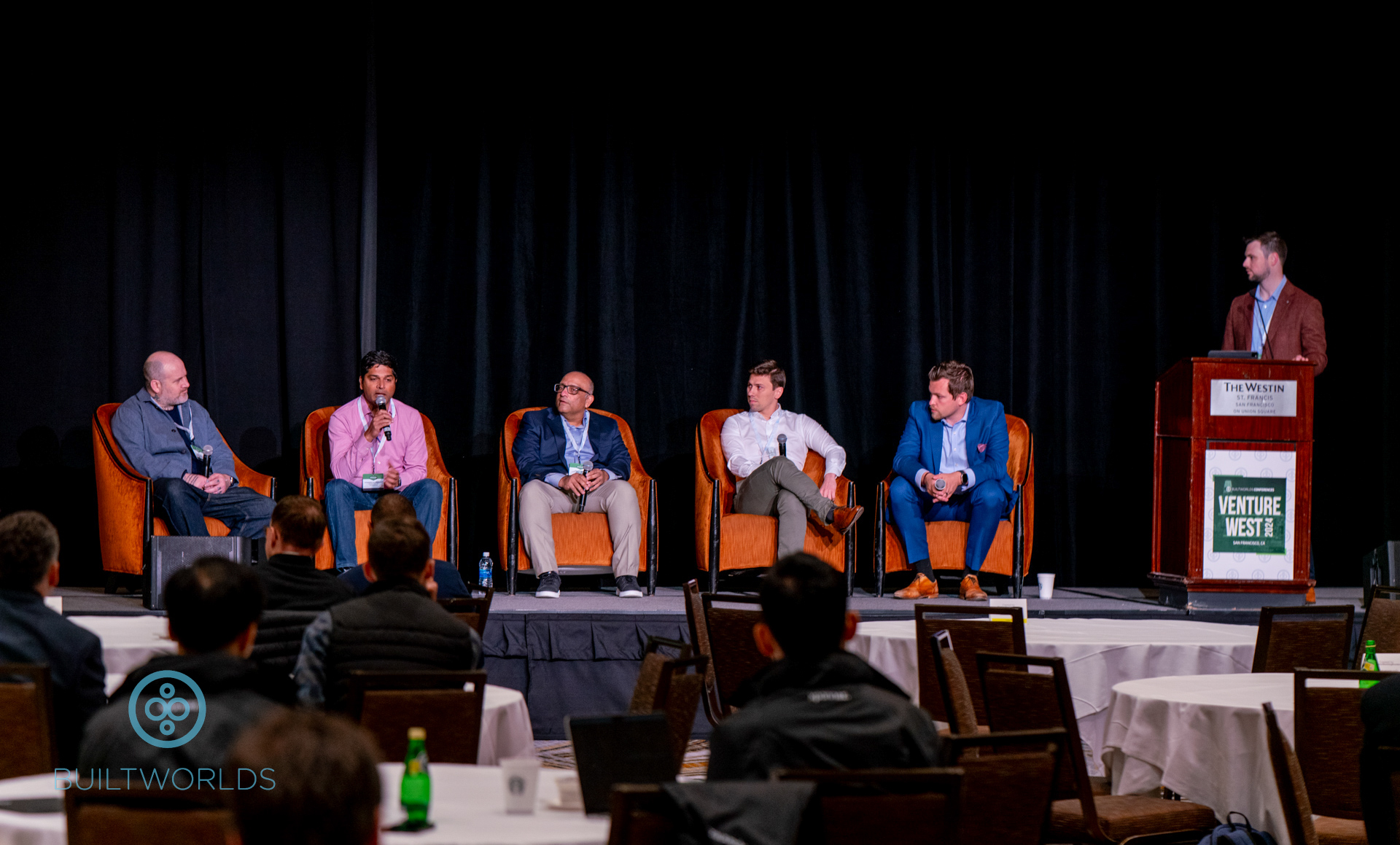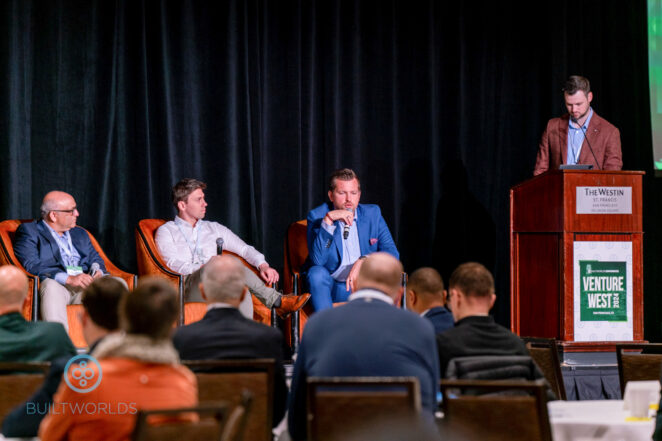
Four insiders weigh in on what it takes to bring a product, service or startup to market
Having a good solution to a problem is not all it takes to bring that solution to market. That much was established firmly and early during the recent Go-to-Market Strategies panel at the BuiltWorlds Venture West conference in San Francisco.
“I think building the product is easy,” said panelist Sadanand Sahasrabudhe, who spent nearly three decades in software, specializing in data and analytics, before co-founding and later serving as the CEO of ConTech startup ConstructivIQ. “It’s go-to-market that’s hard—relatively speaking.”
Of course building a good product isn’t “easy,” per se, but Sahasrabudhe’s point was well received on stage by the four other panelists, each representing a unique background in the ConTech space. There was agreement: going to market is not easy.
“It really comes down to taking something that works in one instance and trying to scale it up … that’s where companies stumble,” said panelist Atul Khanzode, chief technology officer at DPR Construction, one of the biggest contractors in the industry.
Want to watch the full recording?
For a limited time we are making the full panel recording from Venture West available to non-members. Click the button to access the video!
What Makes Up a Good Go-to-Market Strategy?
There are generally two ways to look at a go-to-market strategy: as a company introducing a new product or service to the market, or as a startup introducing itself. In many ways, the two paths are alike. They face similar challenges and offer similar opportunities. They require the same fundamentals to traverse successfully.
Capital Reserves and Proactivity
In an ideal market, industry, world, etc, scaling a product or service or startup from pilot to full go-to-market would be a quick, smooth process. But markets are rarely ideal.
Panelist Caleb Carr started his Colorado-based company Vita Inclinita Technologies in 2009, a year into the country’s worst economic downturn since the Great Depression. The company specializes in load stabilization and serves both the industrial as well as search and rescue industries. In the 15 years since its founding, Vita has become an invaluable resource to the industries it serves.
“To give you context,” Carr said, “we train 90 percent of the civilian-side rescue helicopters in the United States.”
In his years building his company and its products, and through conversations with colleagues, industry peers and leaders, Carr says that for entrepreneurs looking for funding or in the final steps of bringing a product to market, he’s found two things absolutely critical to success: capital reserves and proactivity.
“As much as we’d like to think our industry moves fast, we all know it doesn’t,” he said. “What we’ve learned is that you need to be prepared to make significant capex investments as a company in order to sustain the growth of the organization.”
You also can’t wait around for your customers. “Find ways to drive pilots yourself,” Carr added.
Market Knowledge
Part of that is simply understanding your market - a lesson panelist Maxime De Scheemaeker knows well as head of business development for Belgium-based JuuNoo, a manufacturer of sustainable wall partitions and office pods (and a variety of other office products). As the company works to expand into the US, understanding the markets has proven crucial.
“How can we make sure that these investments will be successful,” Scheemaeker asked. “Is it worth it for us?”
JuuNoo’s first steps into the American marketplace were taken in the local markets in which they hoped to initially expand.
“The first thing we did was interview the right people in local markets to ensure that the assumptions we made were correct,” he said. “And we learned quite fast that what we were doing in Belgium, we could not just copy-paste and do the same in New York.”

Scheemaeker discovered that while the company’s products worked for the people on the ground, its messaging struggled to resonate in the marketplace.
“We were pushing sustainability very hard in the markets until we started listening to our potential customers,” he said. “For them, sustainability was not the driving factor. It was modularity. So even if you’re convinced you should be messaging a certain way, at the end of the day you have to adapt to what your customer wants.”
That theme of listening to the customer struck a chord on stage.
A Clear Understanding of the Customer
As founder of the early-stage venture capital fund Rock Yard ventures, which provides seed funding to startups throughout the construction, supply chain and manufacturing industries, among others, panelist Daniel Dart self-admittedly has “super strong” opinions about go-to-market strategies.
Dart doesn’t like startups that are unclear on how they're going to get their first customers, for instance, or that have seemingly no understanding of their tech stack.
“I always ask … ‘what software are you using today?’,” he said. “A lot of people don’t really know. It’s mind boggling to me.”
To Dart, and the others on stage, these things are as fundamental as knowing your own customer - something with which startups, and many companies taking a new product to market, also seem to struggle.
“A lot of times we have perceptions about how people are using our tool or product, or perceptions about how it’s working for them,” he explained. “I always tell my companies to ask customers, ‘Can I watch you use our software? Can I see you do it?’ Don’t email. Don’t call. Drive down there and just ask.”
“It really comes down to taking something that works in one instance and trying to scale it up … that’s where companies stumble." -Atul Khanzode, chief technology officer at DPR Construction
Dart specifically warned early-stage businesses not to rely on “power users” to drive familiarity and adoption of a product.
“Historically, we’ve not seen that work at the early stages,” he said. “You need to be on the job. You need to be communicating directly.”
That kind of early-stage, boots-on-the-ground customer engagement is crucial because it helps close the sometimes considerable gap between what a business assumes and what it actually knows.
“Every single conversation that I have teaches me something,” said ConstructivIQ CEO Sahasrabudhe. “And I try to feed it back into my top-down strategy.”
“It’s understanding the problem that you’re trying to solve for a very specific customer segment, as well as the value proposition you’re offering in differentiation with your competition,” said DPR Construction CTO Khanzode. ”That to me is sort of the essence of a go-to-market strategy.”
Are you a BuiltWorlds Member?
Our Members have access to full recordings of panels from conferences as well as our weekly analyst calls. If you're a member, click the button to watch the full panel.

Discussion
Be the first to leave a comment.
You must be a member of the BuiltWorlds community to join the discussion.